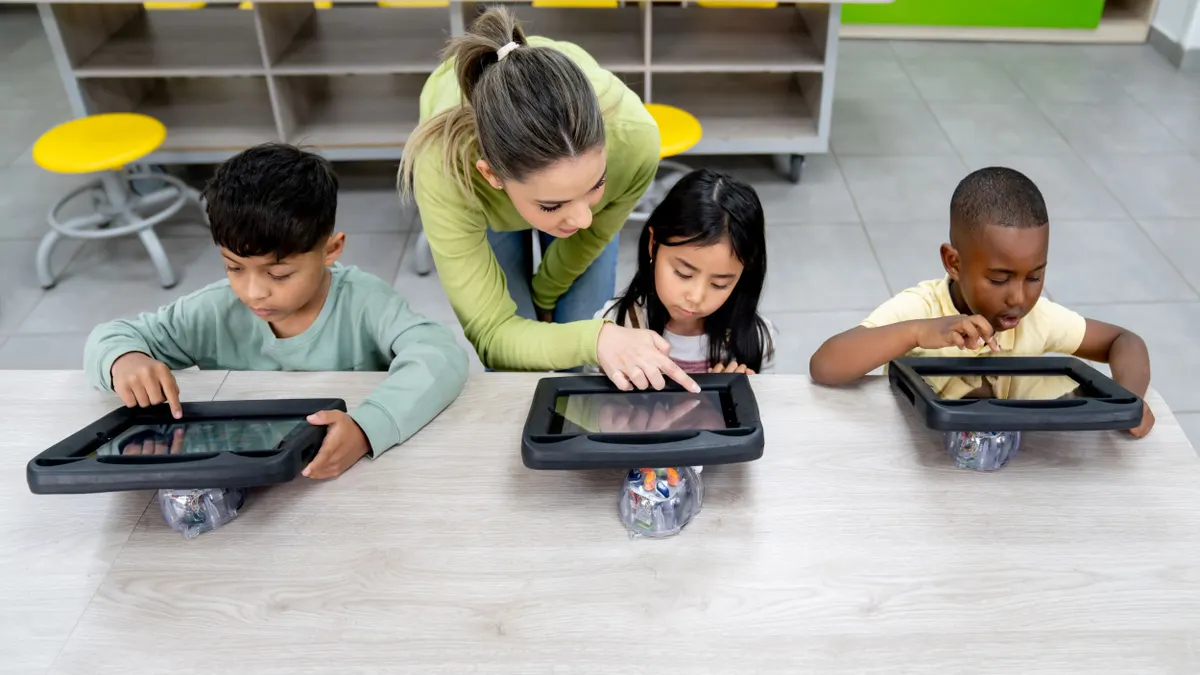Editor's note: For more of our coverage on ITSE, check out our full ITSE recap.
With over 21,000 attendees and exhibitors packing San Antonio's Henry B. Gonzalez Convention Center, this year's International Society for Technology in Education (ISTE) Conference was massive. (It's an assertion backed up by the number of sessions we saw that were so popular they had queue lines in case anyone left.)
As you might expect, a conference with turnout that high could only have a showfloor to match. If you weren't able to make it, or simply didn't have time to see everything, we've highlighted a few of our favorites — from digital textbooks and eMentoring services to game-based learning platforms and robots.
Discovery Education Techbooks
With the advantage of having a highly recognizable name via years of educational documentaries on its TV networks, Discovery’s Education division has cemented a place in the classroom with its line of Techbooks. Available for math, science and social studies, the digital books include model lessons, a variety of activities and assessments, embedded data dashboards, and flexibility across classroom device situations. Its curriculum team also includes subject matter experts, former administrators and other educators.
Additionally, the company’s partnerships with organizations ranging from the NBA to NASA, as well as the ability to adapt content across reading levels and use a combination of text and media, make differentiating content based on student interests easier. Additionally, the company offers the Discovery Educator Network, which simplifies the sharing of best practices and content, as well as a database with a wide selection of vetted material from beyond just Discovery’s vaults.
Sphero
Perhaps best known for its popular BB-8 robot toy, Sphero has a heavy focus in the education market. Its SPRK+ educational model uses the same basic design as its consumer-focused BB-8 toy, but features a translucent shell that allows students to see the robot’s inner workings.
But the inside view of the durable robot’s mechanics is just the tip of the iceberg here. With a corresponding app, students can also learn to use drag and drop block coding, and eventually real languages like Javascript, to program the SPRK’s actions. (The app is also compatible with the Ollie, Sphero, and BB-8 robots, according to the company’s site.)
In the company’s booth at ISTE, we were treated to several demonstrations, including one in an aquarium (the SPRK+ is waterproof and floats) that showed off the measurements from the robot’s motion sensors, presenting additional opportunities for physics lessons.
Cricket Together
It’s no secret that a mentor can make a huge difference in a student’s life, but finding where that fits best during the day can be difficult. With Cricket Together, schools can work with companies to facilitate that opportunity for employees as a fulfilling virtual volunteer opportunity.
The eMentoring platform pairs off students with a company’s employees in a virtual environment, having them read articles and discuss them through digital correspondence. Students see benefits to their literacy, reading and critical thinking skills, as well as getting an additional role model. And employee volunteers are able to share their experiences in a way that fits into their busy schedules. The correspondence also occurs in a safe, secure environment where educators are able to read each letter from either party before it reaches its intended recipient.
Pai Technology
With increased focus on coding and STEM, robots are a pretty big deal right now. Another entrant in that space is Pai Technology, which introduced its Augie robot at this year’s ISTE. Designed with pre-K and early elementary students in mind, Augie teaches kids to code via an app that allows them to program its movements as well as its “eye” display.
But Augie goes a step beyond coding, as well. With its built-in camera, students can also record their own movies and sounds, in addition to engaging in a range of augmented reality activities.
SecondSTEP
From the Committee for Children, the SecondSTEP suite of products offers a full range of social-emotional learning, anti-bullying and child protection programming, presenting a simple approach to achieve the best results in the most cost-effective manner.
The primary SEL program is recommended for students from early learning through grade 8, offering a research-based, media-rich curriculum with fully-scripted lessons and materials designed to engage families at home, as well. The anti-bullying and child protection programs, meanwhile, are recommended for use through grade 5, training staff around best practices for working with all students involved in bullying incidents and how to recognize signs of abuse at home, while students learn how to deal with and report bullying or abuse.
Wonder Workshop
Did we mention robots are HUGE right now? We covered Wonder Workshop’s Dash and Dot robots last year, but for a quick recap: Dot is stationary while Dash moves, they both respond to voice and touch, and their Wonder, Go, Blockly, Path and Xylo apps let students program them to perform a variety of fun activities.
Wonder Workshop this year also unveiled new teacher resources. Chief among them is the K-5 Learn to Code Curriculum, which covers six core concepts and includes 24 lesson plans and 72 Challenge Cards for students. The curriculum is also aligned with standards from CSTA, ISTE, Common Core and code.org’s Computer Science Fundamentals.
Legends of Learning
Along with robotics, educational gaming has seen its star rise in recent years. If you’re a child of the ‘90s, these games are far removed from the simplistic, unengaging learning games you may remember from your school’s computer lab. Modern educational game designers have taken cues from commercial developers to craft experiences that better capture students’ attention spans while effectively teaching concepts that range from the simple to the complex.
Among the top educational gaming companies today, Legends of Learning’s platform offers dozens of options across subjects like earth/space sciences, life sciences and physical sciences. Each game features teacher and student reviews so educators can get an idea of how they’ve worked in other classrooms before adopting them in their own. Analytics can currently be monitored in class, but the company plans to offer comprehensive usage and performance analytics, as well as the ability to make assessments, in 2017.
Teachers can also apply to be ambassadors who work with developers on content for new games.




















